Installing Task Engine on Windows
Note: Service Monitor Agent needs to be installed prior to installing Task Engine. Refer to Installing Service Monitor Agent on Windows for more detailed steps.
Depending on your network scale, you can deploy either a standalone Task Engine, or two for high availability.
Complete the following steps with administrative privileges.
1.Download the netbrain-taskengine-windows-x86_64-10.0.zip file and save it in your local folder.
Tip: Contact NetBrain Support Team to get the download link.
2.Extract installation files from the netbrain-taskengine-windows-x86_64-10.0.zip file.
3.Right-click the netbrain-taskengine-windows-x86_64-10.0.exe file, and then select Run as administrator to start the Installation Wizard.
1)On the Welcome page, click Next.
2)On the NetBrain Task Engine Prerequisites page, view the components that must be deployed beforehand in your environment and click Next.
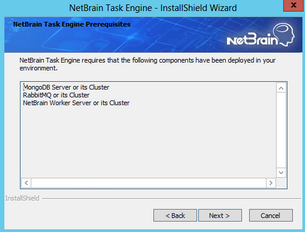
3)On the System Configuration page, review the system configuration summary and click Next.
4)On the License Agreement page, read the license agreements, select the I have read the subscription EULA… check box and then click I ACCEPT.
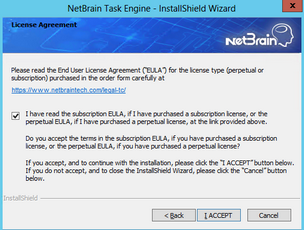
5)On the Customer Information page, enter your company name, and then click Next.
6)On the Destination Location page, click Next to install the Task Engine under the default directory C:\Program Files\NetBrain\. If you want to install it under another location, click Change.
7)On the MongoDB Server Connection page, enter the following information to connect to the MongoDB, and then click Next.
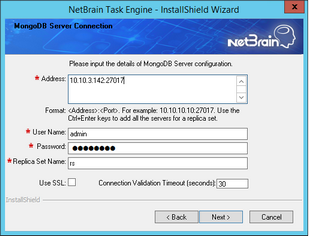
▪Address — enter the IP address or resolvable FQDN of MongoDB and the corresponding port number. By default, the port number is 27017.
Tip: You can enter the fully qualified domain name (FQDN) of MongoDB if all NetBrain servers are managed in the same domain. For example, test.netbraintech.com:27017.
▪User Name — enter the username that you created when installing MongoDB.
▪Password — enter the password that you created when installing MongoDB.
▪Replica Set Name — enter the replica set name of MongoDB. Keep the default value rs as it is unless you changed it.
▪Use SSL — used to encrypt the connections to MongoDB with SSL. If SSL is enabled on MongoDB, select this check box; otherwise, leave it unchecked.
▪Validation Timeout (seconds) — it is used to set the connection timeout threshold (in second) to validate the connection to the dependent server. This will not affect the application running timeout value.
8)On the RabbitMQ Connection page, enter the following information to connect to RabbitMQ, and then click Next.

▪Address — enter the IP address or resolvable FQDN of RabbitMQ.
Tip: You can enter the FQDN of RabbitMQ if all NetBrain servers are managed in the same domain.
▪User Name — enter the admin username that you created when installing RabbitMQ.
▪Password — enter the admin password corresponding to the username that you created when installing RabbitMQ.
▪Port Number — enter the port number used by RabbitMQ to communicate with Web API Server, Worker Server, and Task Engine. By default, it is 5672.
▪Use SSL — used to encrypt the connections to RabbitMQ with SSL. If SSL is enabled on RabbitMQ, select it; otherwise, leave it unchecked.
▪Validation Timeout (seconds) — it is used to set the connection timeout threshold (in second) to validate the connection to the dependent server. This will not affect the application running timeout value.
9) (Required only if the Use SSL check box is selected when configuring the connections to MongoDB or RabbitMQ.) On the Certificate Configuration page, configure whether to authenticate the CA of SSL certificates used on MongoDB or RabbitMQ, and then click Next.
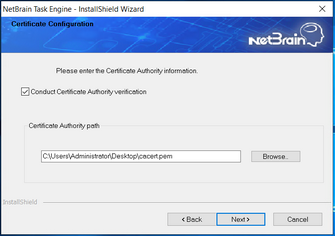
To authenticate CA:
a)Select the Conduct Certificate Authority verification check box.
b)If the CA has not been installed on this machine, click Browse to import the CA certificate file, for example, ca.pem.
Note: Only the certificate in Base-64 encoded X.509 PEM format is supported.
Note: The following conditions must be met for the CA certificate file:
- The CA certificate must contain CRL Distribution Points property with valid CRL HTTP distribution point URL. (CRL stands for Certificate Revocation List.)
- The CRL Distribution Points URL must be accessible to Web Server/Worker Server.
- Internet access must be ensured if the certificate is signed by third-party CA.
10) Review the summary of the installation information and then click Install.
11) (Optional) Ensure the NetBrain installation process using administrator account has the necessary permissions to modify “User Rights Assignment” in “Local Security Policy” or change the local user privileges. Otherwise, the following error message will prompt when installing each Windows component.
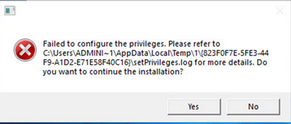
Click Yes to continue with installation/upgrade process and NetBrain service will be configured to run as Local System. If you have security concerns, please click No to abort the installation/upgrade.
Note: Local System accounts have additional privileges that are considered a high risk. Please verify that this is an acceptable risk in accordance with your SysAdmin policies.
Note: After clicking No, please check with your system administration team to enable the relevant permissions, uninstall the affected component(s) and reinstall. Contact NetBrain support team if you need any assistance during the process.
4.After successfully installing the Task Engine, click Finish to complete the installation process and exit the Installation Wizard.
5.Open the Task Manager and navigate to the Services panel to check that the NetBrainTaskEngine service is running.
6.For high availability, you can install one more Task Engine on another machine by repeating the above installation steps.
Note: Make sure that each Task Engine has the same configurations for Worker Server, MongoDB, and RabbitMQ. And your network configurations allow communications among them.
Verifying Configurations of Task Engine Cluster
After configuring the cluster, you can log in to the RabbitMQ Management page to browse all cluster nodes.
1.In your web browser, navigate to http(s)://<IP address of RabbitMQ>:port_number. For example, http://10.10.3.142:15672. 15672 is the default port number for the RabbitMQ Management Plugin.
2.Enter the username and password that you created when installing the RabbitMQ, and then click Login.
3.Select Queues > nb_flowengine_leader.
4.Click Consumers. The Task Engine cluster nodes are listed.

The first one is the active node responsible for active operation management. The other one is the standby node.
